Related Research Articles

The Ruthenian Greek Catholic Church or Byzantine Catholic Church, is a sui iuris (autonomous) Eastern Catholic church based in Eastern Europe and North America. As a particular church of the Catholic Church, it is in full communion with the Holy See. It uses the Byzantine Rite for its liturgies, laws, and cultural identity.

The Catholic Church in Ukraine is part of the worldwide Catholic Church, under the spiritual leadership of the Pope in Rome. Catholics make up 10% of the population of Ukraine.
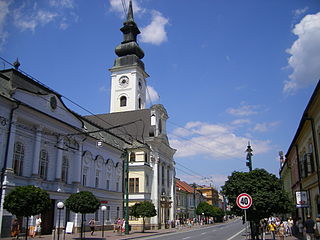
The Slovak Greek Catholic Church or Byzantine Catholic Church in Slovakia, is a sui iuris (autonomous) Eastern Catholic church based in Slovakia. As a particular church of the Catholic Church, it is in full communion with the Holy See. The church is organised as a single ecclesiastical province with one metropolitan see. Its liturgical rite is the Byzantine Rite. In 2008 in Slovakia alone, the Greek Catholic Church in Slovakia had some 350,000 faithful, 374 priests and 254 parishes. In 2017, the Catholic Church counted 207,320 Greek Catholics in Slovakia worldwide, representing roughly one percent of all Eastern Catholics.
Basil Takach was the first bishop of the Byzantine Catholic Metropolitan Church of Pittsburgh, the American branch of the Ruthenian Greek Catholic Church.
Stephen John Kocisko was the first Metropolitan Archbishop of the Byzantine Catholic Metropolitan Church of Pittsburgh, the American branch of the Ruthenian Greek Catholic Church

The Archeparchy of Pittsburgh is an archeparchy of the Ruthenian Greek Catholic Church that is located in the southern part of the United States of America. It is part of the Metropolis of Pittsburgh. The geographical remit of the archeparchy includes the states of Alabama, Arkansas, Kentucky, Louisiana, Mississippi, Pennsylvania, Tennessee, Texas, and West Virginia. The incumbent archeparch is the Most Reverend William C. Skurla. The episcopal seat is situated in the city of Pittsburgh.
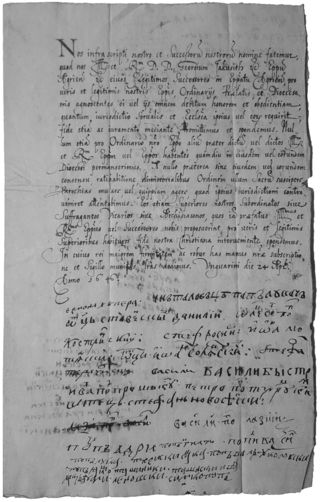
The Union of Uzhhorod, was a decision by 63 Ruthenian priests of the Orthodox Eparchy of Mukachevo to join the Catholic Church made on April 24, 1646. Until rediscovery of its founding document in 2016, academics had debated the actual date of union, whether a document had been signed, and even whether the Union of Uzhhorod had even transpired at all.
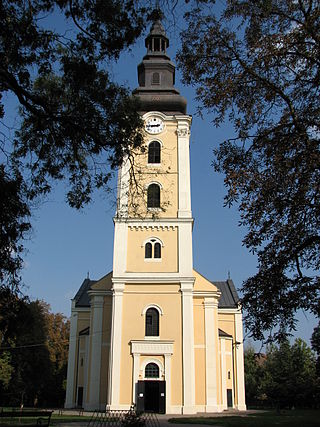
The Archeparchy of Hajdúdorog is an archeparchy of the Hungarian Greek Catholic Church which is an Eastern Catholic particular church of the Catholic Church that is in full communion with the Holy See. The archeparchy is the metropolitan see of its ecclesiastical province which covers the whole of Hungary. The archeparch is also, ex officio, the metropolitan bishop of the metropolis. The cathedral church of the archeparchy is the Cathedral of the Presentation of Mary in the city of Hajdúdorog.

The Eparchy of Križevci is a Greek Catholic Church of Croatia and Serbia eparchy of the Catholic Church in Croatia, Slovenia, and Bosnia and Herzegovina. Its current eparch is Milan Stipić. The cathedra is in the Cathedral of the Holy Trinity, in the episcopal see of Križevci, Croatia.
Petro Parfenii Petrovich was an Orthodox Bishop and a Basilian monk who united the Ruthenian Church with Rome.
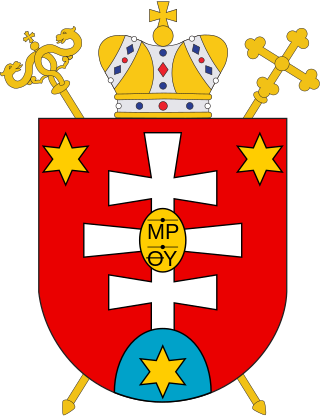
The Greek Catholic Eparchy of Mukachevo is an eparchy (diocese) of the Ruthenian Greek Catholic Church that was erected by the Pope Clement XIV in 1771. The geographic remit of the eparchy includes the south-western parts of Ukraine that are roughly within Zakarpatska Oblast. As an Eastern Chatholic Church, it is in full communion with the Catholic Church. The eparchy is exempt, which means that it does have a metropolitan bishop but is directly subject to the Holy See. It is supervised by the Roman Dicastery for the Eastern Churches, a Roman Curia dicastery acting on behalf of the Pope. Its parishes observe the Byzantine Rite which is also celebrated by the majority of Orthodox Christians, and as provided for in the original terms of the Union of Uzhhorod. The episcopal seat is the Cathedral of the Exaltation of the Holy Cross in the city of Uzhhorod.

The Saint Nicholas Monastery Ukrainian: Миколаївський Мукачівський жіночий монастир is an Eastern Orthodox monastery located on Chernecha Hora in Mukachevo, Ukraine. It belongs to the jurisdiction of Eparchy of Mukachevo and Uzhhorod of the Ukrainian Orthodox Church. It is a female monastery, headed by hegumenia Epistimiya Sherban.

The Italo-Albanian Catholic Church or Italo-Albanian Byzantine-Catholic Church is one of the 23 Eastern Catholic Churches which, together with the Latin Church, compose the Catholic Church. It is an autonomous (sui juris) particular church in full communion with the Pope of Rome, directly subject to the Roman Congregation for the Oriental Churches, but which follows the Byzantine Rite, the ritual and spiritual traditions that are common in most of the Eastern Orthodox Church. It uses two liturgical languages: Koine Greek, the traditional language of the Eastern Churches, and Albanian, the native language of most of its adherents.
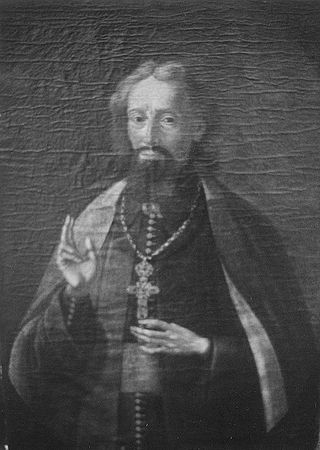
Manuil Mykhaylo Olshavskyi, O.S.B.M., was the bishop of the Vicariate Apostolic for the Ruthenians in Mukacheve from 1743 to his death in 1767.

Holy Cross Cathedral is a Greek Catholic cathedral of Eparchy of Mukachevo in Uzhhorod, Ukraine. It is dedicated to the Exaltation of the Holy Cross.
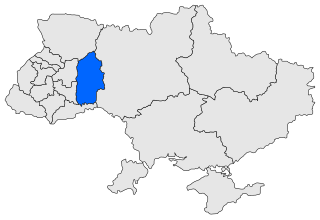
The Ukrainian Catholic Eparchy of Kamyanets-Podilskyi is an eparchy of the Ukrainian Greek Catholic Church sui iuris in its homeland Ukraine.

The Exarchate of Saints Cyril and Methodius of Toronto is a ecclesiastical territory or exarchate that serves the Slovak Greek Catholic Church — a sui juris or self governing Eastern Catholic Church. Its geographical remit includes the whole territory of Canada. In 2022, Pope Francis transferred the ecclesiastical jurisdiction of the exarchate from the Slovak Greek Catholic Church to the Ruthenian Greek Catholic Church. It became part of the ecclesiastical Metropolis of Pittsburgh. This changed the territory's status from an eparchy to an exarchate at the same time.
The Eparchy of Lutsk–Ostroh was a suffragan eparchy of the Metropolis of Kiev, Galicia and all Ruthenia in the Ruthenian Uniate Church and the Ukrainian Greek Catholic Church. It was situated in the Polish–Lithuanian Commonwealth. Later, it was an Eastern Catholic titular see from 1921 to 1973.
The term Eparchy of Mukachevo may refer to:
The Eparchy of Mukachevo and Prešov was an Eastern Orthodox diocese (eparchy) of the Serbian Orthodox Church, that existed from 1931 to 1945. It had jurisdiction over regions of Slovakia and Subcarpathian Rusynia, at that time parts of former Czechoslovakia. Its seat was in Mukachevo.
References
- ↑ encyclopediaofukraine.com,
- ↑ [ http://atravellerincarpathia.com/?p=243 atravellerincarpathia.com]